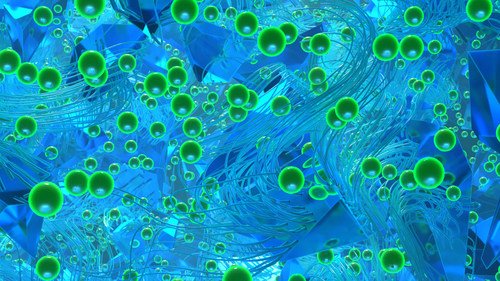SARS-CoV-2, influenza A virus inactivated by zinc-impregnated nylon fabric
19 September 2021 | Sunday | News

An illustration of zinc ions actively suspended in a nylon polymer matrix. A recently published study found the combination of zinc and nylon 66 to be effective at absorbing and inactivating viruses.
An international team of scientists and engineers from the University of Cambridge, the Icahn School of Medicine at Mount Sinai, ResInnova Labs and Ascend Performance Materials has discovered that a nylon fabric impregnated with zinc ions has successfully inactivated 99% of the viruses that cause COVID-19 and influenza.
Masks, protective clothing and filters are used to slow the spread of viruses. But poor-quality masks can harbor active viruses from infected people, which poses a risk of transmission.
"Absorption and inactivation is a major challenge," said Vikram Gopal,M.D., co-lead co-author and chief technology officer at Ascend Performance Materials. "Respiratory viral diseases, such as COVID-19 and influenza, are transmitted by droplets and aerosols. Polypropylene, the material of commonly used disposable masks, is a hydrophobic plastic that does not absorb moisture. Instead, viruses can remain on the surface of the mask, which poses a risk of transmission when handling the mask. »
Cotton is also a problem, according to Dr. Gopal. "Cotton effectively absorbs moisture, but it does not render the virus inactive, which again poses a risk of transmission," he said.
In the paper published in the journal ACS Applied Materials Interfaces,the researchers described how a nylon 6-6 fabric impregnated with active zinc ions absorbs moisture droplets containing viruses and effectively inactivates the particles. The tissue allowed a reduction of 2 logs, or 99%, of viral particles in one hour.
The research team was also able to demonstrate that nylon containing active zinc ions remains stable over time, retaining its virus-inactivating properties after 50 washes.
"The study shows how nylon textile with zinc performs better than widely used cotton and polypropylene materials for virus absorption and inactivation," said Dr. Gopal.
The findings have a significant impact on the future development of PPE, Dr. Gopal said.
"Pathogen-free PPE doesn't just reduce the risk of transmission of the virus," Gopal said. "By making PPE washable and reusable, you reduce the need for single-use products, preventing hundreds of millions of masks from being thrown away."
Most Read
- Biotech and Biopharma Industry Trends: What to Watch for in 2024
- Revolutionizing Drug Discovery: 15 AI Companies to Watch in 2024
- Pioneering Precision: Top 15 Clinical and Lab Diagnostic Companies to Watch in 2024
- 2024's Biopharma Roadmap: Top 24 Biopharma Trends to Watch in 2024
- Breakthroughs Unveiled: A Year of Groundbreaking Novel Drug Approvals in 2023
- Revolutionizing Tomorrow: Top 24 Emerging Biotech Innovations to Watch in 2024
Bio Jobs
- Leica Microsystems Announces Vacancy for Senior Imaging FPGA Testing Engineer in Singapore
- Glen Godresse Takes Helm as CEO of Menarini Asia-Pacific
- Eva van Pelt Joins Qiagen's Supervisory Board, Bringing a Wealth of Global Leadership Experience in Healthcare and Life Sciences
- Life Sciences Queensland Welcomes Dr. Kym Baker and Dr. Denise Hodge to Board Leadership
- Bayer appoints Nelson Ambrogio as new Head of Radiology Business at Pharmaceuticals Division
- Danaher Careers - Search Global Science and Technology Jobs
- Careers at MERCK Group
- Ajinomoto Bio-Pharma Services Announces Leadership Changes at US Facility
- Veranova Appoints Mike Riley as Chief Executive Officer
- Find your Job at Eppendorf
News
Editor Picks











